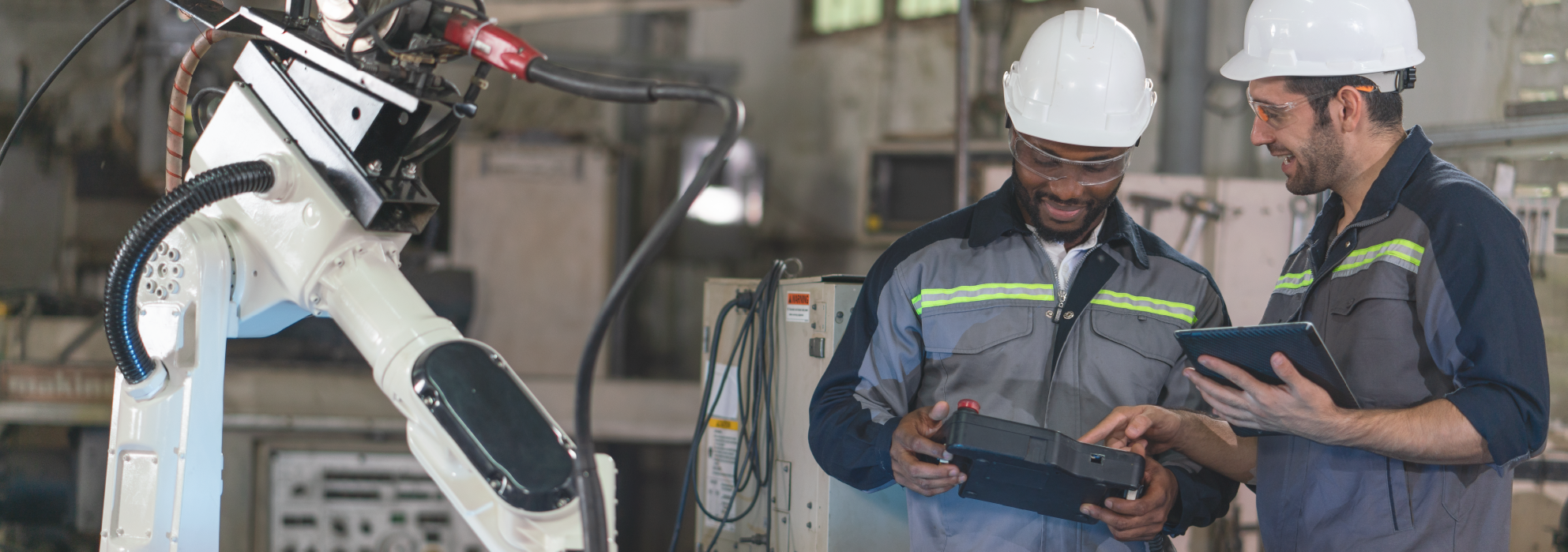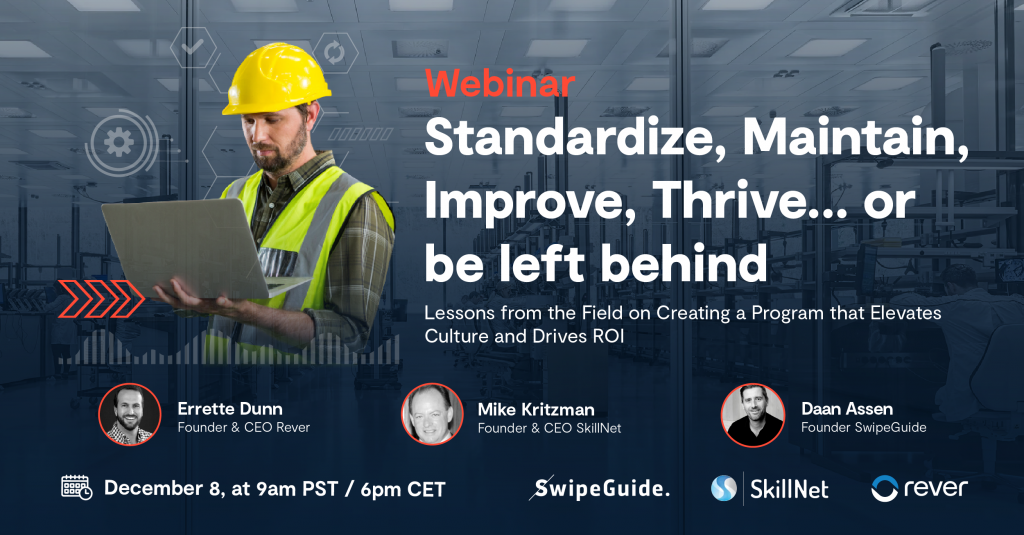Series (2/6): Power of Standardization and Standard Work
8 minutes, 43 seconds read

Learn more about, and connect with, our presenters on LinkedIn:
Errette Dunn, Founder & CEO Rever (learn more about Rever)
Daan Assen, C0-founder SwipeGuide (learn more about SwipeGuide)
Mike Kritzman, Founder & CEO SkillNet (learn more about SkillNet)
Host: Ralf VonSosen, Chief Solution Office, Rever
In this segment, we look at the importance of establishing standards across operational execution and how driving standard work is a dynamic initiative.
Watch here! See the live discussion.
Ralf VonSosen:
Let’s talk a little bit about standardization of processes and work instructions. Daan, maybe you could talk a little bit about that, how that’s maybe changed and accelerated, not just with what we’ve seen in the pandemic but with digitization. Modern technology and the expectations that new workers may have, has had a big impact on this as well.
Daan Assen:
Technology as an enabler. I normally would like to start from the problem, but we’ll get there. Technology as an enabler, has proven to be of great value in these times. And of course with the new workforce coming in, the expectations are higher on what digitization is available in manufacturing companies, because people are used to working with technologies in their daily lives. So the standard is higher in that sense to also continuously enable people. What we see from the problem perspective, and linking that back to technology, is related to resilience. We have customers that started with SwipeGuide for documenting their standards and make them accessible just in time. Some food and beverage companies capture their standard operating procedures in our cloud platform and make sure that information was available as they faced heavy workforce turnover issues.
There were a lot of things happening in the workplace that were really pushing towards standardization and making sure that a person that was trained to work on production line one, can now also assist on production line three with well-documented standards. We see that across the board. A lot of cases also related not only to COVID, but also to the issue of experienced staff leaving companies. We also have cases where we work with experts to capture expert knowledge in digital standard work that can then be utilized for building the future of the company. An example we had recently from Deutsche Bahn is around train maintenance where one expert engineer could do train repairs of all types, but a lot of other people couldn’t. Trains sometimes stood in the depot for five day days, creating a lot of downtime. We captured all that expert knowledge in SwipeGuide, where we then created standard that even novice engineers could perform these maintenance tasks easily leading to less downtime. That’s the kind of situation that companies are looking for to make sure that your operations are, robust. I think standard work, capturing knowledge, making that available either through on the job training or for supporting people during their work is critical.
Ralf VonSosen:
I can only imagine a German train operator having trains sitting still in the anxiety he would potentially feel.
Daan Assen:
We also had a wine producer, for instance, same issue. One Person dropping out, and an issue that needs to be, cannot be addressed and you’re stuck for three days. So capturing that knowledge, making it available so others can pick up on the work easily is very critical. That’s maybe giving a bit of depth to the term resilience. That’s what we mean when we say resilience.
Ralf VonSosen:
Errette and Mike, anything that you’d like to add.
Mike Kritzman:
Standards are so important. As an engineer, I think this way. The world needs more standards. Fundamentally, you know, standards in the workforce apply broadly to so many areas we focus on. My passion is around creating standards in terms of role definition. What is someone supposed to be skilled at to perform certain operations? That’s why for the frontline we strongly recommend using certifications, creating standards and then certifying that people have met those standards. So that you create the resilient standard that was talked about.
Errette Dunn:
I’ll add a few recommendations in thenapproaches of creating or updating standards. ‘ve had this role in the past as an industry engineer where I’m tasked with creating the work procedures and standards, and then go down to the shop floor to present these standards as the law. This is what you’re supposed to follow. Well, that is not necessarily the best approach. It rarely matches the reality of the shop floor and the needs of the shop floor. As an industry engineer, you are not on the shop floor all the time. The best people to build those standards alongside with the experts, are the people performing the job. So capturing the knowledge and experience of people who’ve been doing this work for years, that know the obstacles being faced, is crucial to engage those employees who will do the job of documenting the work instructions and the best way to do things.
The second thing I’ll add is to not perceive standards as being written on stone. Most companies say this standard is the way we do things around here and you have to follow it. Whereas when I started at Toyota, the philosophy around standards was significantly different. Aa standard is the current best way we know in performing this job until we find a better way. And there is always a better way. So make sure that wherever you document your standards, they are also easy to access and update.
Ralf VonSosen:
If you establish these standards, how do you maintain those standards and how can technology help? The fact that standards aren’t cast in stone as much as they are current best practice shows that as the products evolve as supply chains evolve, as knowledge evolves, they need to adapt. That’s part of resilience.
Daan Assen:
How do you maintain it? If you look at maintenance of these standards as something you want to have as a shared responsibility then technology of course is hugely powerful. We like to see standards not as a one time effort as a continuous effort where you try to find ways of improving. The ideas for the improvement are there in the frontline. The people in offices don’t know how to come to these improvements like the people that perform the job on a daily basis and encounter issues. That’s where we see that technology can help democratize knowledge.
It’s not only the knowledge from the ivory tower of engineering. It’s also the knowledge from the people on the shop floor. If you engage the people on the shop floor, or on the frontline, to speak broader then it gives them a sense of ownership of the standard. Then it’s not some department saying “you have to perform your job like this”. It becomes a collaboration with the team on the front line to document the processes. Establish to the frontline that it’s their standard, they’re responsible. They can improve it. It’s a dynamic process and you provide them with the technologies to do so. We put a lot of effort in making sure that our sort of editing part of SwipeGuide is available on tablets so people on the shop floor can easily document standards and push them out.
Technology also helps you manage the quality and compliance of those standards We support for instance, workflows where in a crowdsourced approach to standards can verify with the right people new ideas about areas and processes are safe and up to par in terms of quality and efficiency before they are pushed out as new standards. The maintenance of standards only works in a distributed model. A hybrid model that involves the frontline in the creation and improvement of standards. Ensuring you have your checks and balances in place to make sure that every job is done the right way, and maintains the appropriate quality and compliance.
Ralf VonSosen:
Absolutely. Errette, I can see the sparkle in your eyes, when we talk about democratization and empowering the frontline.
Errette Dunn:
It’s tapping into the knowledge of people. They’re the ones who are facing the daily issues on the shop floor every single day. When talking about the maintenance of standards, do not make it a yearly grand event to update standards. The only way to systemically really address an issue is by making sure that whatever standards or checklists there are, they are updated and by the best people, at the source. Finding those issues and finding the solutions for a better standard are best done by your frontline employees. Get the principles right first, and then document them.
It’s a fundamental change of how you manage your standards. It’s why Wikipedia is much more valuable, accessible, rich, and up to date than encyclopedia Britanica. Whenever you want to make an update or a correction to the printed encyclopedia, the logistical process is a nightmare, right? Just editing, printing, distributing it and so on. The technology side of what enables Wikipedia to be Wikipedia is not just a nicer way to distribute it. It’s at its core to make it much more collaborative, alive, and up to date. I fully recommend diving into the technological side of managing standards.
Read more from this wonderful discussion:
- Adjusting Operations to the Ongoing Pandemic (1 of 6)
- Power of Standardization and Standard Work (2 of 6)
- Driving Continuous Improvement (3 of 6)
- Building and Managing Skills (4 of 6)
- Leveraging the Power of Technology (5 of 6)
- Advice for 2022 – It’s about your people (6 of 6)
OR, watch the Video Recordings (each is 5-10min in length):
- Adjusting Operations to the Ongoing Pandemic (1 of 6)
- Power of Standardization and Standard Work (2 of 6)
- Driving Continuous Improvement (3 of 6)
- Building and Managing Skills (4 of 6)
- Leveraging the Power of Technology (5 of 6)
- Advice for 2022 – It’s about your people (6 of 6)
Like this content? Sign up for our Newsletter
[hubspot type=form portal=561211 id=fda6d445-739e-4072-8dae-68b94971a266]THE FRONTLINE DOJO
More Articles
How to develop the next billion Knowledge Workers
3 minutes, 51 seconds read
Digital transformation in manufacturing is not what you think it is
10 minutes, 36 seconds read
The human side of change management: lessons learned from Toyota, Airbus, and Silicon Valley
1 minute, 28 seconds read
The true meaning of Genchi Genbutsu
3 minutes, 5 seconds read
